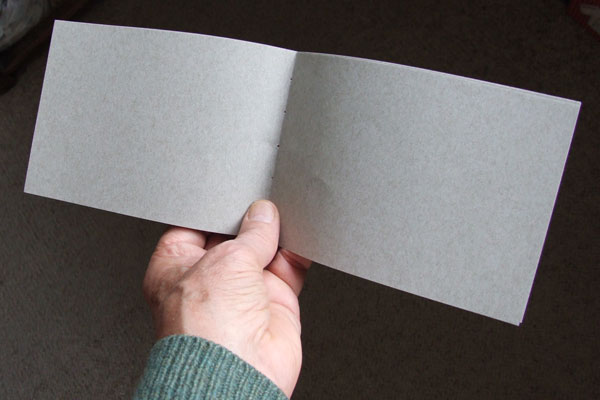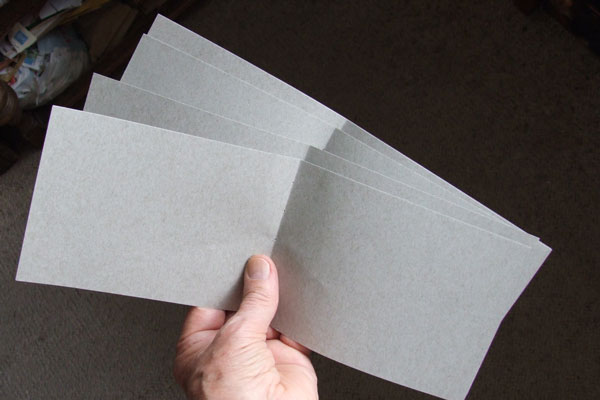
A folio in the making ~
The finished size will be A6 in this case
Folio has a number of meanings. Throughout this busybusydotco site I concentrate on just one meaning ~ a single piece of paper that has been folded ~ just once ~ to form a mini book ~ of four pages ~ two leaves ~ all from one sheet [115136]. (Some people might claim that a single sheet so folded is not a book ~ nor even a booklet. 'Pamphlet' is sometimes used. I leave that discussion to others.) I suspect it is also slightly incorrect to use the word 'folio' when it should be 'bifolio'.

Bookbinders use the word folio. There are several meanings for the word ~ and confusion might arise if either speaker or listener has different views on the matter. The solution is to make it clear ~ in detail ~ as to what you are saying. Alternatively ask to clarify the the speaker's meaning of the word 'folio'.

Language such as 'This piece of paper will finish at size A6 with a landscape ~ or view ~ or horizontal ~ format' is unlikely to be misunderstood. note that the words finish ~ size ~ format are used and all are essential.
The folio is the main element to the whole history of codex-style bookbinding [125223].
The other meanings attached to the word folio are normally clear from the context. I have met with the following interpretations ~
I understand that typographers refer to the page number as the folio. This meaning may be clear from appropriate context but could be a real source of confusion in general conversation. The whole topic of foliation ~ of putting sheets ~ pages ~ sides ~ leaves ~ in correct order is part of the quagmire that keeps historians busy in the inner sanctums of learned libraries. Well beyond discussion here ~ but I had a delve into the www and found some fascinating snippets. For those with time and inclination ~ Happy hunting!
A folio is understood by some people to mean a single sheet of paper, or a leaf. For some the leaf has to be numbered in order to qualify as a folio.
A folio is sometimes interpreted as a large book ~ especially historically. (As in Shakespeare's plays. A quote from a past Christie's Auction Catalogue lists the following item ~ 'The First Folio # 1623 ~ contains 36 plays, 18 of which had not previously been printed, and which would otherwise have been lost forever.' Their estimate of the value of a similar book was £1million.)
Sometimes a folio might refer to one half of a sheet once it has been cut into two pieces.
The word portfolio is sometimes shortened to folio, because of the folded V-shape of the covers.
Whilst researching and checking on this I learnt that a folio can also mean a bundle of accounts or a particular legal document ~ the characteristic being that just one number refers to the whole thing ~ which maybe has four pages ~ or not. (As, maybe, 'see folio 23ff'.) I am not prepared to get entangled with either the accountancy or legal professions, but would as always, be glad to share any knowledgeable and reliable information.
Similar entanglements ensue when talking about old documents. Sometimes the folio itself is numbered ~ rather than the two sides it sometimes has ~ or maybe the four ~ sides. The number is then appended with recto or verso to describe which of the 'pages' are being discussed [112703]. This causes abbreviations such as 'f3 r.' and 'f27 v.' It is good typestting practice to restrict the length of line to ~ about ~ ten words. On a large sheet this requires the use of columns ~ eg newspapers. These are lettered a~b~c~. Thus we arrive at 'f3 v. col. b'. I am entangled enough.
